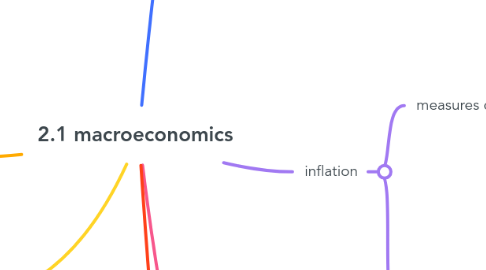
1. inflation diagram
1.1. cost push
1.2. demand pull
1.2.1. p
2. jj
3. unemployment
3.1. causes:
3.1.1. frictional
3.1.1.1. this type of unemployment happens as people are changing jobs
3.1.2. seasonal
3.1.2.1. This happens with the seasonal shifts in aggregate demand (eg in winter unemployment decreases) this is why governments adjust for thee when looking at their data
3.1.3. cyclical
3.1.3.1. this happens as there are finical crashes slowdowns and recoveries reflected in Aggregate demand
3.1.4. structural
3.1.4.1. This is when a certain industry goes down and people are not skilled in other areas - normally happens with de-industrialisation.
3.1.5. real wage
3.1.5.1. as companies increase real term wage growth creating an over supply in labour
3.2. definition - people that are willing and able to work but aren't
3.2.1. underemployment
3.2.1.1. the number of people who are working but want a second job/ longer hours
3.3. measures
3.3.1. independant labour organisation survey
3.3.1.1. why is the ILO always higher then the claiment count?
3.3.1.2. because some people who are eligible for unemployment benefits don't take them
3.3.2. Claimant Count
3.3.2.1. this is the number of people that claim unemployment benefits
4. inflation
4.1. measures of inflation
4.1.1. CPI- consumer price index
4.1.1.1. definition- the tracking of prices changes of a basket of 700 goods and services an "average family" uses.
4.1.1.1.1. pros
4.1.1.1.2. cons
4.2. meaning- the persisitant increase in prices year over year
4.2.1. deflation
4.2.1.1. the persistant decrease in prices year over year
4.2.2. disinflation
4.2.2.1. a lower inflation in prices from the past year
5. macroeconomic objectives
5.1. Balance of accounts
5.1.1. wants to make sure that it equates to even ammount
5.2. Unemployment rate
5.2.1. wanted rate is ~4%
5.3. Growth
5.3.1. BoE wants economic growth at 2.5%
5.3.1.1. this is because it is sustainable yet still expanding
5.4. Buget defecit
5.4.1. want to reduce deficit
5.5. Enviroment
5.5.1. wants to reduce carbon emmisions
5.6. Inflation
5.6.1. BoE wants rate of 2%
5.7. Inequality
5.7.1. wants to reduce this
6. Balance of accounts
6.1. Credit Acccount
6.1.1. imports
6.1.2. exports
6.1.3. investment income
6.1.4. transfers
